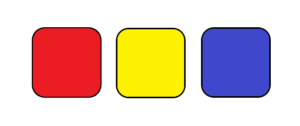Chapter 1 – Back to the Basics
1.1 Colour Theory
Colour has three main characteristics: Hue, level, and intensity.
Hue
You will have learned in Hairstylist Foundations that the three primary (or “pure”) colours are red, yellow, and blue.

Every colour (or hue) that exists is the result of mixing two or three primary colours in varying proportions.
When all three are mixed in varying, yet fairly equal amounts, these primary colours create our natural looking hair colours from light to dark. But how?
Let’s have a look at the colour wheel:

As you can see above, the colour wheel contains:
- Our three primary colours
- Red
- Yellow
- Blue
- Three secondary colours, created by mixing two primary colours together
- Orange
- Green
- Violet
- Six tertiary colours, created by mixing a primary colour with its neighbouring secondary colour.
- Yellow-orange
- Red-orange
- Red-violet
- Blue-violet
- Blue-green
- Yellow-green
The position of each of these colours on the wheel indicates its tone. In the graphic above, the left side of the colour wheel contains our cool colour tones (green, blue-green, blue, blue-violet, violet, and red-violet), while the right side contains our warm colour tones (red, red-orange, orange, yellow-orange, yellow, yellow-green).
Colours that sit directly across the wheel from each other are called complementary colours. Mixing two complimentary colours together will create a brown or grey colour result. Voila! Our natural, neutral hair colours are born!
Level
The level of hair colour is the darkness or lightness of colour in relation to itself and other colours. Level is the direct result of how these colours are mixed.
For example, what happens if you have an abundance of blue in your mixture? Or an abundance of yellow? Because blue is the darkest of the primary colours, an abundance of blue creates our darker levels. Yellow is considered the lightest, and so a majority of yellow in our mixture results in our lighter levels.
Universally, hair colours exist from a level 1-10, with 1 being darkest and 10 being lightest. Some colour manufacturers may use a 1–12 system, with 12 being the lightest colour level.

Intensity
Finally, intensity refers to the strength, or saturation, of colour. A colour will be much more saturated at a darker level compared to a lighter level. Colours are most intense in their “pure” form. For example, the red gradient below.

So how do the 3 main characteristics of colour, hue, level and intensity, affect how you will formulate artificial hair colour?
Remember this principle?
Existing hair colour + artificial hair colour = resulting hair colour
This means that in order to create the desired results, you must understand how to alter the existing hair colour with an artificial colour formulation.
Let’s get started: Imagine that you have a new client sitting in your chair. Would you simply have them choose a hair swatch and slap that colour on? Hopefully not!
Before you head to the colour room to begin mixing up a colour formula, you must assess the following:
- What is the client’s existing hair colour? This includes the hue (or tone), as well as the level.
- What is the client’s desired hair colour result? Again, this should involve a discussion about hue and level, as well as intensity.
- Is the client going darker or lighter?
- Do you want to enhance or neutralize the existing colour?
In Chapter 2: The Consultation, we will have a more in-depth look at each of these factors. For now, let’s revisit the science of hair, trichology, to explore how the hair strand itself can influence your colour choices.
Media Attributions
- All images in this chapter are by A. Magtiza and are under a CC BY 4.0 Licence.
A colour or shade.
The darkness or lightness of colour in relationship to other colours.
The strength or saturation of colour.
"Pure" colours that cannot be created by mixing. They are red, blue, and yellow.
A tool used by stylists for hair colour assessment and formulating
Colours created by mixing two primary colours. These are orange, green, and violet.
Colours created by mixing a primary colour with its neighboring secondary colour. They are yellow-orange, red-orange, red-violet, blue-violet, blue-green, and yellow-green.
The shade or hue.
Colours which sit across from eachother on the colour wheel, and when mixed, cancel eachother out to create a grey/brown neutral colour.
The hue, level, and intensity that exists in a client's hair prior to a colour service. This could refer to natural colour or previous artificial colour.
Oxidative or non-oxidative colour products that are added to the hair in order to change its hue, level, or intensity.
To add to the intensity or vibrance of a colour.
To counteract or drab the intensity or hue of a colour.

